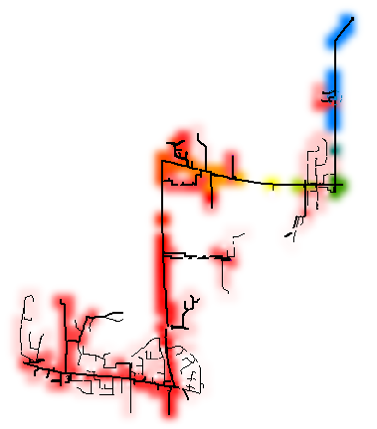Quanta Technology performs hosting capacity studies to determine the ability of a utility to accommodate and integrate future distributed energy resources (DER) on its grid. The results of these studies are used to develop hosting capacity maps for the utility’s service territory and its distribution feeders. In general, hosting capacity analysis considers the effect of DER proliferation, specifically photovoltaic distributed generation, on thermal limits and voltages of distribution feeders. We also have experience with hosting capacity studies that consider additional variables in creating develop hosting capacity maps; these variables may be incorporated progressively into the calculation process to increase result accuracy and comprehensiveness. Quanta Technology also supports our client partners with creating general guidelines that identify areas of the distribution system that are more vulnerable to the potential effects of DER adoption based on further analysis of capacity maps. We can also support updates to hosting capacity maps, periodically and automatically, to account for actual changes in DER penetration levels (driven by new interconnection requests), changes in system configuration, customer load growth, etc.
Hosting Capacity
Our Services
Our Distribution team is comprised of industry experts with extensive utility experience. We have a strong customer focus to ensure that our clients’ objectives are fully and effectively met. Our service offerings are flexible so that they can be tailored to meet specific client objectives.
Growth of Distributed Generation
The growth of solar photovoltaic and wind distributed generation is changing how utilities operate and plan their distribution grids. The transition from large central station plants to distributed generation plants have affected both transmission and distribution grids. The impact is greater on distribution grids since most of them were designed and built as radial systems where power flows in one direction to loads. With distributed generation, the power flow is bi-directional up to the point of exporting energy to the transmission at certain times.
However, distributed generation falls under a broader category of DERs which includes grid-connected energy storage, electric vehicles, and microgrids. In the case of microgrids, for example, all the above distributed energy resources could be connected to the electric grid and presenting challenges for the grid operator to accommodate all of them without causing adverse impacts.
Location Dependent
As with any distribution planning study the location of any new generation resource is important as the power flow is dependent on the source, the grid infrastructure, and other planned additions or modifications to the feeder. Each feeder has its own characteristics that must be considered such as minimum and maximum loads, power factor, the presence of voltage control devices (voltage regulators or capacitor banks), and conductor type.
The physical connection to the distribution grid creates impacts that vary based on location. Hosting capacity evaluates the impacts of DERs at varying line sections and nodes on the distribution feeder.
Time Varying
Traditionally, distribution planners focus on the peak load conditions for their annual planning criteria, but due to the intermittency associated with DER, planning studies must look at maximum and minimum load conditions. Loading affects voltage conditions and if DER generation is variable by nature, it cause the voltage to vary as well. The planner must study multiple generation and load conditions to account for all potential impacts.
Hosting Capacity
Hosting capacity—also known as integration capacity analysis (ICA)—can be performed on most major power flow platforms. Many utilities require customization for their specific needs which can be done using scripting tools and common coding languages. The results are often transferred to geographic databases and illustrated in heat maps. This coding should be done by someone with deep knowledge and experience like Quanta Technology.

As voltage varies, it may cause flicker problems that must be addressed. In addition, the variation of load and generation, depending upon time of day and environmental conditions, may cause reverse power flow toward the source substation. This reverse power flow may not be desirable and may have impacts on the substation transformer load tap changer and any line voltage regulators. There may be issues related to reverse power flow at the feeder head or back onto transmission.
Feeder Specific
In distribution, no two feeders are identical, so each has its own operating characteristics affecting its load carrying capability, manifested in thermal limits for conductors and line devices. Traditionally, the hosting capacity is determined feeder by feeder, requiring a power flow analysis for each.
We conduct assessment of line components (conductor, insulators, hardware) and structures using various inspection technologies and practices, as well as quantitative analysis of maintenance and failure data. Our capabilities include assessing structure deterioration from corrosion and evaluating structural integrity. Our transmission line evaluation also includes assessing UG transmission, including pipe-type systems.
Protection
DER has the potential to impact the protection coordination scheme for distribution feeders. Studies should address mis-operations, sympathetic trips, and potential reduction in sensitivity.
Most major power flow software vendors offer hosting capacity modules to facilitate analysis. Often, distribution planners need to enhance the simulations using scripting tools such as Python. Quanta Technology is a leader in this field and has evaluated thousands of feeders.

